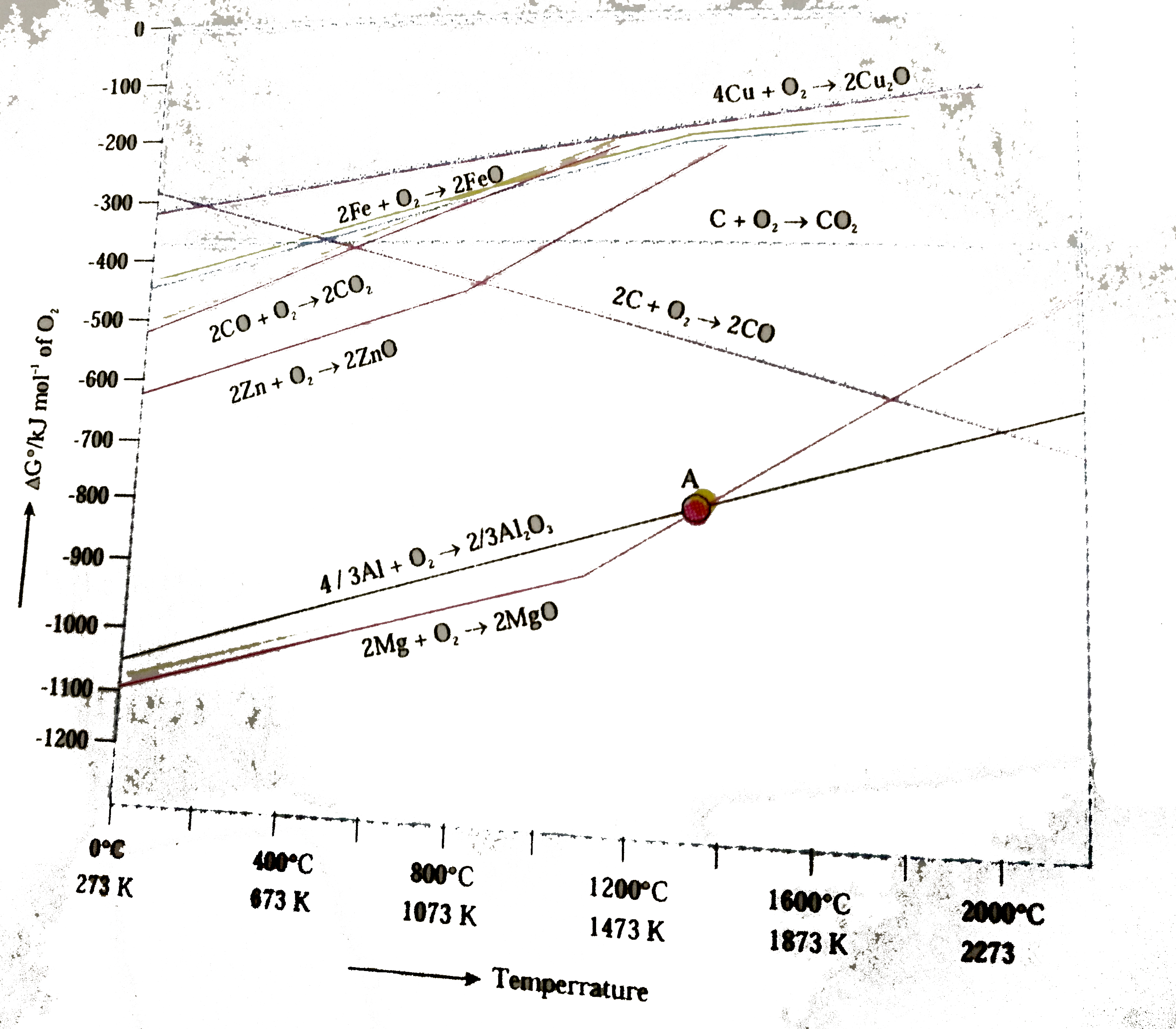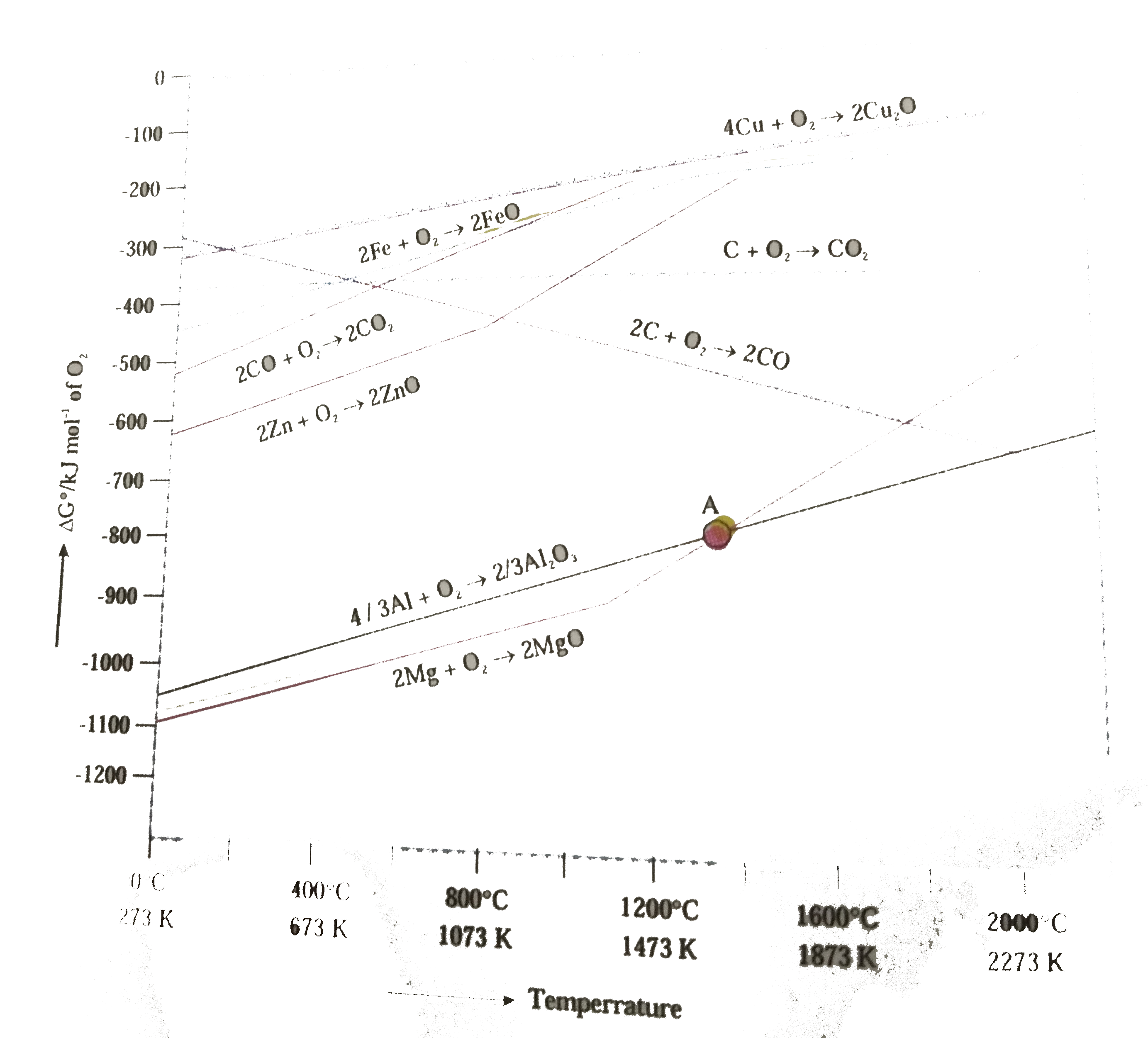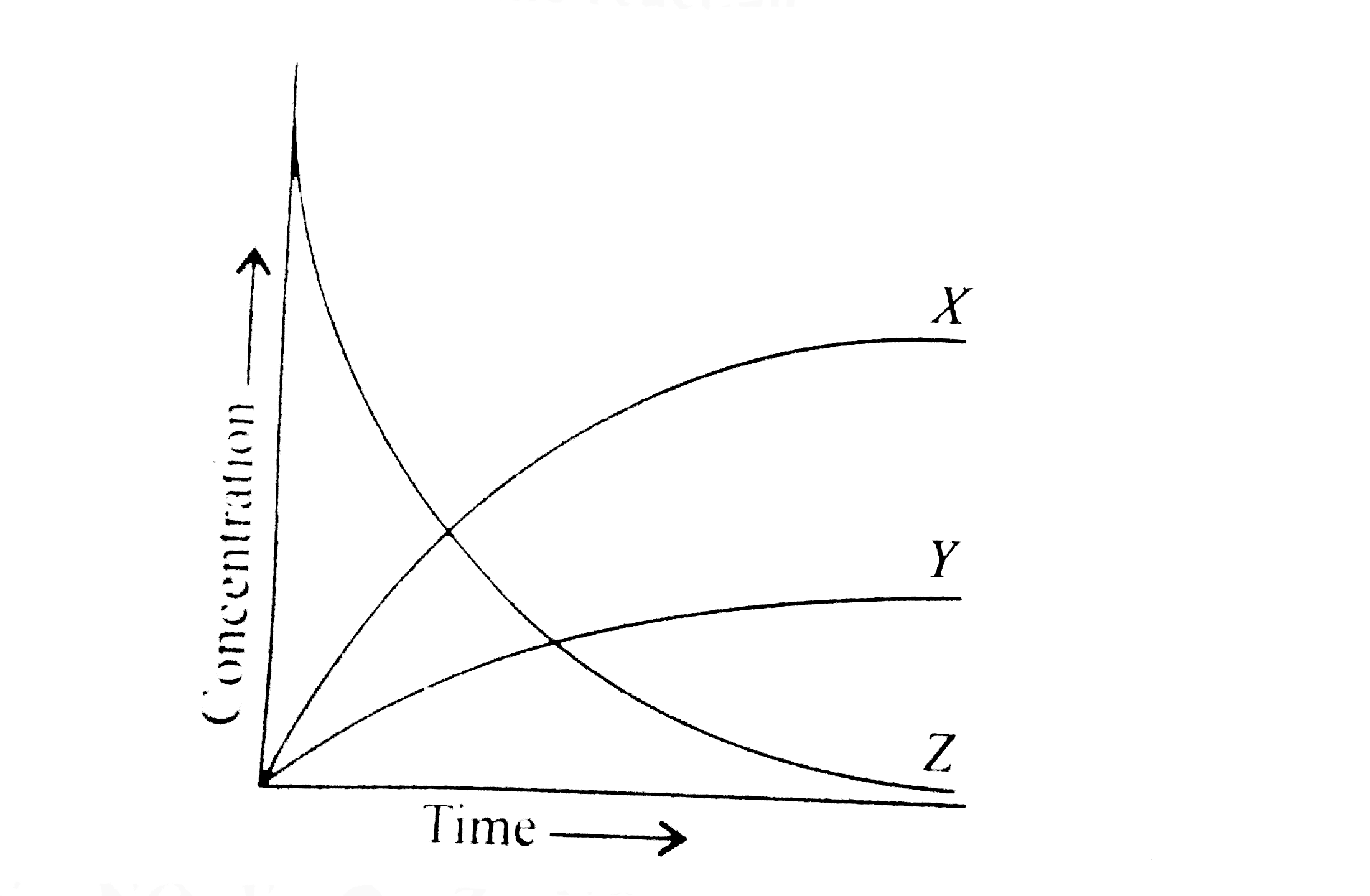The formation of the oxide MxOyper mole of O2 cinsumed is written a 2xyM(S)+O2(g)→2yMxOy the free energy change of the reaction is given by ?G=?H-T?S.
if the ethalpychange?H and ethropy change ?S are assumed to be indendent of temperature the plot of ?G versus T is liner such as shown in th efollowing figure known as Ellingham diagram Figure known a sEllingham diagram Figure is widely used to discuss th priciple ionvolves in the extraction of metal from its oxide.
![The formation of the oxide M(x)O(y)per mole of O(2) cinsumed is written a (2x)/(y)M((S))+O(2(g))to(2)/(y)M(x)O(y) the free energy change of the reaction is given by ?G=?H-T?S. if the ethalpychange?H and ethropy change ?S are assumed to be indendent of temperature the plot of ?G versus T is liner such as shown in th efollowing figure known as Ellingham diagram Figure known a sEllingham diagram Figure is widely used to discuss th priciple ionvolves in the extraction of metal from its oxide. chorose correct statement from from the following (I) For the reducation of by 'c' [to be spontaneous ] (II) DEcreasng ease of reduction of metal oxides by carbon is (III) Decreasding ease of reduction of metal oxides by caron is (IV) Resduction of by Al possible at all temperatures](https://d10lpgp6xz60nq.cloudfront.net/physics_images/NAR_CHM_XII_V03_C06_E01_515_Q01.png)
chorose correct statement from from the following
(I) For the reducation of by 'c' [to be spontaneous ]
(II) DEcreasng ease of reduction of metal oxides by carbon is
(III) Decreasding ease of reduction of metal oxides by caron is
(IV) Resduction of by Al possible at all temperatures
I,iv
ii,iii
ii,iv
iii,iv
The correct Answer is:c
Similar Questions
The formation of the oxide MxOyper mole of O2 cinsumed is written a 2xyM(S)+O2(g)→2yMxOy the free energy change of the reaction is given by ?G=?H-T?S.
if the ethalpychange?H and ethropy change ?S are assumed to be indendent of temperature the plot of ?G versus T is liner such as shown in th efollowing figure known as Ellingham diagram Figure known a sEllingham diagram Figure is widely used to discuss th priciple ionvolves in the extraction of metal from its oxide.
The reduction of by carbon at may be repesented as the free energy of this raction can be obtained from the following two reactions.
Choose the correct statement
View SolutionThe formation of the oxide MxOyper mole of O2 cinsumed is written a 2xyM(S)+O2(g)→2yMxOy the free energy change of the reaction is given by ?G=?H-T?S.
if the ethalpychange?H and ethropy change ?S are assumed to be indendent of temperature the plot of ?G versus T is liner such as shown in th efollowing figure known as Ellingham diagram Figure known a sEllingham diagram Figure is widely used to discuss th priciple ionvolves in the extraction of metal from its oxide.
The reduction of by carbon at may be repesented as the free energy of this raction can be obtained from the following two reactions.
Choose the correct statement
View Solution
Knowledge Check
The formation of the oxide MxOyper mole of O2 cinsumed is written a 2xyM(S)+O2(g)→2yMxOy the free energy change of the reaction is given by ?G=?H-T?S.
if the ethalpychange?H and ethropy change ?S are assumed to be indendent of temperature the plot of ?G versus T is liner such as shown in th efollowing figure known as Ellingham diagram Figure known a sEllingham diagram Figure is widely used to discuss th priciple ionvolves in the extraction of metal from its oxide.
choose correct statement from the following StaementsAThe slope of linear plot of
ΔG versus T is positive for MXOywith the excepitio when 'M' is carbon.BThe slope of linear plot of ΔG vercus T is nagative for CO2Cthe slope of plots of ΔG Versus T is positive for CODThe slope of plats of ΔG cversus to T for the varouos oxides formed from M(S)(or)M(l) are nagativeThe formation of the oxide MxOyper mole of O2 cinsumed is written a 2xyM(S)+O2(g)→2yMxOy the free energy change of the reaction is given by ?G=?H-T?S.
if the ethalpychange?H and ethropy change ?S are assumed to be indendent of temperature the plot of ?G versus T is liner such as shown in th efollowing figure known as Ellingham diagram Figure known a sEllingham diagram Figure is widely used to discuss th priciple ionvolves in the extraction of metal from its oxide.
choose correct statement from the following StaementsAThe slope of linear plot of
ΔG versus T is positive for MXOywith the excepitio when 'M' is carbon.BThe slope of linear plot of ΔG vercus T is nagative for CO2Cthe slope of plots of ΔG Versus T is positive for CODThe slope of plats of ΔG cversus to T for the varouos oxides formed from M(S)(or)M(l) are nagativeConsider the following reaction:
2NO2(g)→2NO(g)+O2(g)
In the figure below, identify the curves X,Y, and Z associated with the three species in the reaction
 AX=NO,Y=O2,Z=NO2BX=O2,Y=NO,Z=NO2CX=NO2,Y=NO,Z=O2DX=O2,Y=NO2,Z=NO
AX=NO,Y=O2,Z=NO2BX=O2,Y=NO,Z=NO2CX=NO2,Y=NO,Z=O2DX=O2,Y=NO2,Z=NO
For a reaction 4M(s)+nO2(g)→2M2On(s),
the free energy change is plotted as a function of temperature. The temperature below which the oxide is stable could be inferred from the plot as the point at which :
View SolutionFor a reaction 4M(s)+nO2(g)→2M2On(s),
the free energy change is plotted as a function of temperature. The temperature below which the oxide is stable could be inferred from the plot as the point at which :
View SolutionConsider the following reaction:
2NO2(g)→2NO(g)+O2(g)
In the figure below, identify the curves X,Y, and Z associated with the three species in the reaction

View SolutionThe heat changes for the reaction:
H2O(s)→H2O(l) is known as
View SolutionΔn, the change in the number of moles for the reactin, C12H22O11(s)+12O2(g)⇔12CO2(g)+11H2O(1)at25∘C is
View Solution
